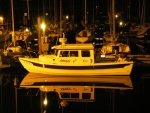My take on 22 batteries is that they should be equal. There are plenty of marine batteries which are more than adequate to do both house and engine start. My favorite is the group 31 AGM from Sam's Club: "DuraCell" Made by East Penn: same as Deka. Most boats come with a group 24--which is a bit small. I feel minimum are two group 27's. The golf cart batteries are great for a larger boat--not much space to put them in a 22 or 16. Even the 25 it is a pinch.
The reason for equal batteries, is for similar charging characteristics. When batteries are combined--as when in "all" It is best that batteries be same type, size and age. If not there can be unequal charging.
The idea of rotating batteries between start and house is a good one. When you "start" use #! one time and #2 the next etc. After the engine is running, then combine the batteries--with "All". When you get to a destination, anchor or stay overnight go to one battery. (#1 or #2, but not "all".) That way when you go to start the engine, there should be one fully charged battery.
I prefer to "automatically " combine. This is done with a voltage sensitive relay (VSR) also called a combining relay. When the engine starting battery gets to over 13.7 volts the VSR combines the batteries, and they both charge. When the voltage drops below 12.7 volts the "combiner" or VSR disconnects the two batteries leaving the start battery isolated. This gets away from "I need to turn the switch to "All" or leaving them both connected and waking up to two dead batteries.
There are many more things one can do for battery management. if you have complex systems three batteries and battery management with a gauge such as the Victron 702, which monitors amps used and amps put into the battery. It also gives very accurate state of charge and voltage.
Do not discharge a battery to less than 50% state of charge. This is 12.2 volts at a steady state. (no current in or out for an hour,)
I have been experimenting with a lithium ion battery which has the "power" of two golf carts (6 volts in series to give 12 volts and 110 amp hours usable). This battery weighs 29#, is in a group 24 size case, and should be good for at least 10 years. It has 110 amp hours usable. Down side is cost, and the necessity to keep isolated from other types of batteries (It is a slightly higher voltage at rest, and if combined with a flooded lead acid, AGM or Gel, would overcharge that battery and harm the Li ion. There needs to be a special charger to top it off, but bulk charging can be done by motor or standard battery charger.


